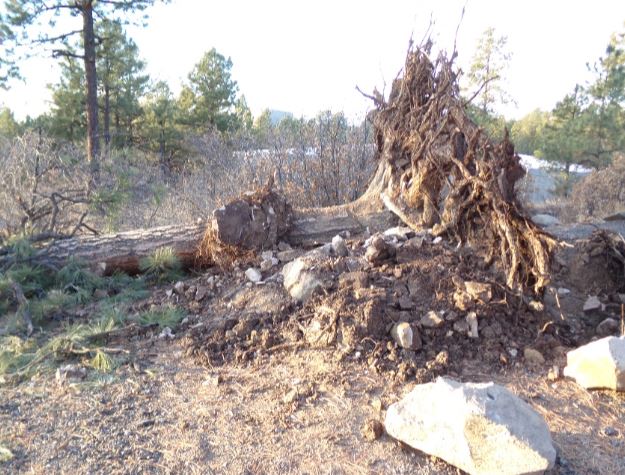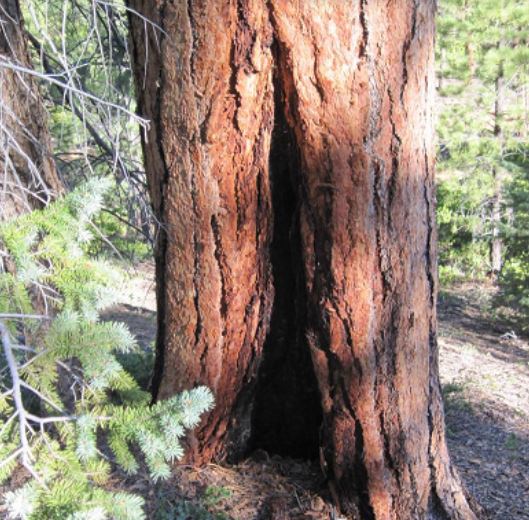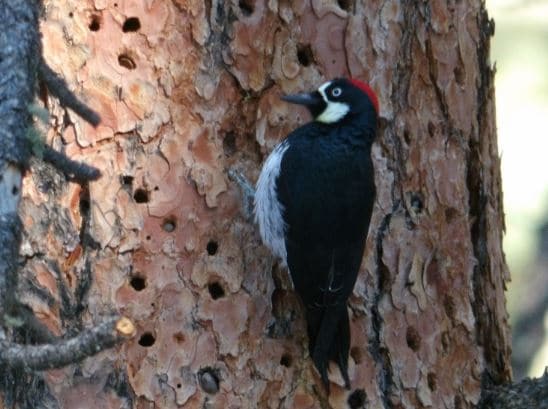 Picture 1: The flacking sheets of bark of a ponderosa tree. Photo by Robert Dryja
Picture 1: The flacking sheets of bark of a ponderosa tree. Photo by Robert Dryja
 Picture 2: A fallen ponderosa tree with its ring of roots pointed skyward. Photo by Robert Dryja
Picture 2: A fallen ponderosa tree with its ring of roots pointed skyward. Photo by Robert Dryja
By ROBERT DRYJA
Los Alamos
Picture 1 is of a fallen ponderosa tree. A count shows 86 rings from the center of its trunk to its outside. This trunk has a radius of 9 inches from its center to outer edge. This is nearly ten rings per inch representing ten years of growth. The distance between rings varies somewhat depending on how much growth occurred from year to year, reflecting weather conditions.
The bark is composed of nine layers but the layers do not continue around the tree like the inner rings. It is in patches.
Picture 2 shows that the bark is like a flaky skin, protecting the tree from infestations and fires. A one-inch-thick layer of bark provides heat protection if a tree is in a forest fire. Burning pieces can fall away from a tree, keeping the fire from burning directly on the tree trunk.
Picture 3 shows a trunk that was mostly protected in a fire but has a burn scar on one side of it. An insect would need to burrow one to two inches through the bark to reach the inner trunk for nourishment. Most insects would find this too far. However, a woodpecker may like the relatively soft bark created by the layers.
It may punch multiple holes in the bark for storing seeds, as shown in Picture 4.
Younger ponderosa trees do not have a tap root that grows deeply down into the earth. Instead, their roots spread out horizontally, forming a ring that grows relatively close to the surface. This arrangement means that it can absorb more water close to the surface rather than the smaller amount that eventually sinks deeply into the earth. Picture 2 shows the roots of the fallen tree. These form a ring twelve feet high. “Younger” means being less that 100 years old. Older trees grow a tap root and may live to be 400 to 500 years old.
Ponderosa trees will grow in groups. Although there may some distance between tree trunks, they still can be close to one another with their spreading branches. Trees then support each another if one should start to lean over in a strong wind. The tree in Picture 2 was at a distance from other trees when a wind gust measured at 60 miles per hour passed through the area, toppling it.
What happened during the 86 years of this tree’s life? The Los Alamos Ranch School started in 1917 and the tree started growing 1935. The school and the tree therefore came into existence at approximately the same time. It was 11 years old in1946 when housing in the western area of Los Alamos was started. The trunk then was two inches in diameter. The first hydrogen bomb was tested in 1954 when the tree was 19 years old. The trunk now was four inches in diameter. The first man to the moon was in 1969 and tree now was about six inches in diameter. It finally reached eighteen inches in diameter in 2021, just before it toppled over.
A ponderosa tree grows in one spot. A tree might measure time based on how many inches in has grown. Growth to one foot in diameter represents 57 years, based on the measurements of the fallen tree. One of the largest living ponderosa trees measures nine feet diameter. This size indicates the tree is 513 years old. Imagine two trees seeing one another. “Oh, you are youngster, your just five inches in diameter”. “Hello Grandma, what does it feel like to be three feet in diameter?”
 Picture 3: A burn scar with the trunk now growing around it. Photo by Stanley G Kitchen
Picture 3: A burn scar with the trunk now growing around it. Photo by Stanley G Kitchen
 Picture 4: An Acorn woodpecker busily making holes in the bark. Some of the holes have a seed placed in them. Photo by Robert Dryja
Picture 4: An Acorn woodpecker busily making holes in the bark. Some of the holes have a seed placed in them. Photo by Robert Dryja

